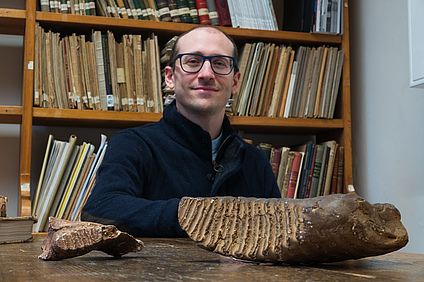Diving into the past to investigate the demise of island dwarfs and giants
Chronicles of a paleontologist at sDiv
I have always been fascinated by reconstructing past ecosystems and exploring the potential use of the fossil record to gather information for conservation planning. Thus, right from my PhD days, I have sought to integrate elements of paleoecology, biogeography, and conservation paleobiology into my research. Towards the end of 2018, following the conclusion of my first postdoc project at the Natural History Museum of Berlin, I noticed that iDiv’s synthesis centre sDiv was advertising a postdoctoral call. Intrigued by this opportunity, I decided to apply with a paleo-project. While I was familiar with iDiv as a centre of excellence for biodiversity research and conservation, I was fairly certain that there were no in-house paleontologists (little did I know that I would become the first paleo-postdoc at sDiv). Luckily, stars aligned and I could spend over two years at sDiv investigating how evolution towards dwarfism and gigantism has influenced the risk and rate of extinction of mammals on islands, in collaboration with iDiv Biodiversity Synthesis professor Jonathan Chase and a team of researchers from 10 countries. Jonathan Chase, an expert in biodiversity change across spatial scales, was intrigued by the opportunity to embark on his first venture into the ‘paleo’ side of ecology and shed light on island biodiversity using a unique data set.
The evolutionary “oddities” of island life stand out as some of the most spectacular phenomena in the natural world, yet islands contain a disproportionately higher amount of threatened and extinct biota compared to continents. From dwarf hippos and elephants, deer with bizarre antlers and giant rats - the roster of weird island mammals is vast, both in the fossil record and today. Personally, I have always been captivated by the ecologically naive nature of these taxa. This has motived me to delve into the relationship between their peculiarity and their vulnerability, especially after human colonization. In the main output of the sDiv postdoc project, published earlier this year in Science, we found that the likelihood of extinction and of endangerment are highest in the most extreme island dwarfs and giants. Sadly, our results revealed that extinction risk of insular mammals was compounded by the arrival of modern humans, which accelerated extinction rates more than 10-fold (Rozzi et al., 2023). While new arrivals and faunal turnovers are part of the natural dynamics of island ecosystems, we showed that the effect of the arrival of modern humans and their introduced biotas on global extinction rates of island mammals was unprecedented, at least since the beginning of the Quaternary.
Assembling and synthesizing the most extensive database on extant and fossil insular mammals to date has represented a crucial phase of this project and taught me about the perseverance and time required for synthesis. Throughout the pandemic, while working from home every day, gathering data from hundreds of papers, books, and excavation reports occasionally felt akin to a near-monastic experience. The input of collaborators and the support of two student assistants, Louise Dädlow and Lena Husemann, funded by sDiv, were of great help during this phase of the project, which spanned nearly two years. In total, we compiled data on extinction risk, body mass and body size shifts of 1231 extant species and 350 extinct species of insular mammals. Moreover, we assembled a dataset of >7800 fossil occurrences from over 1400 sources representing 182 islands and paleo-islands worldwide spanning 23.03 Ma (Rozzi et al., 2023). While the data mobilization work of the students may not have always been particularly exciting due to its repetitive nature, both students were integral parts of the sDiv team and are now pursuing careers in science, partially still within the iDiv consortium.
Despite the challenges posed by the pandemic, my time at iDiv has been an incredibly rewarding experience. Virtual lab meetings, coffee breaks, and various other initiatives have allowed us to stay connected and fostered networking opportunities even while confined to our homes. As the situation gradually improved, these connections blossomed into fruitful collaboration. For instance, I was part of a team that reviewed the effects of many types of scale in detecting ecological thresholds (Spake et al., 2022) and I had the opportunity to contribute to a study that assessed global species abundance distributions of Eukaryotes (Callaghan et al., 2023). Furthermore, data gathered for the sDiv postdoc project laid the foundation for collaboration with other fellow island-enthusiasts at iDiv investigating the distribution of palms in Madagascar and the evolution of insular woodiness (Méndez et al., 2022; Zizka et al., 2022). Finally, being exposed to so much inspiring research in ecology and biodiversity science and having the opportunity to receive feedback and learn from colleagues across different research labs, particularly those in sDiv and Biodiversity Synthesis, have greatly benefited my paleontological research.
Earlier this year I joined the Central Repository of the Natural Science Collections (ZNS, in German only) at Martin Luther University Halle-Wittenberg as Curator of Paleontology. As thrilled as I am to return to collection-based work, conservation paleobiology and synthesis will continue to play a pivotal role in my research. ZNS is part of iDiv’s unique science consortium and I am excited about the prospect of further collaborations.
Roberto Rozzi
Cited literature
Méndez, L. et al. (2022). Megafrugivores as fading shadows of the past: extant frugivores and the abiotic environment as the most important determinants of the distribution of palms in Madagascar. Ecography, 2022(2).
Spake, R. et al. (2022). Detecting thresholds of ecological change in the Anthropocene. Annual Review of Environment and Resources, 47, pp.797-821.
Zizka, A. et al. (2022). The evolution of insular woodiness. Proceedings of the National Academy of Sciences, 119(37), p.e2208629119.
Rozzi, R. et al. (2023). Dwarfism and gigantism drive human-mediated extinctions on islands. Science, 379(6636), pp.1054-1059.
Callaghan, C.T. et al. (2023). Unveiling global species abundance distributions. Nature Ecology & Evolution, pp.1-10.

